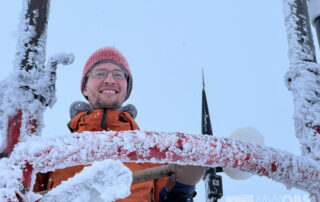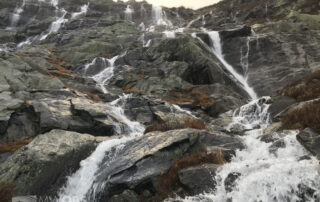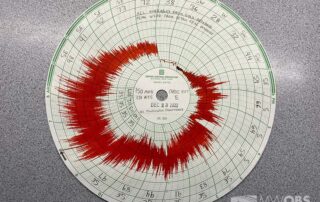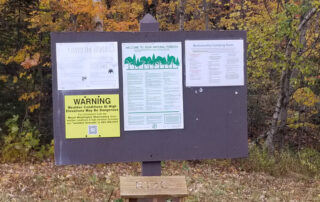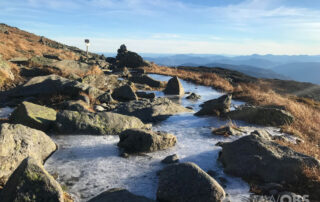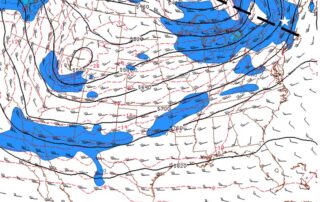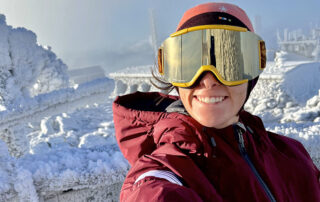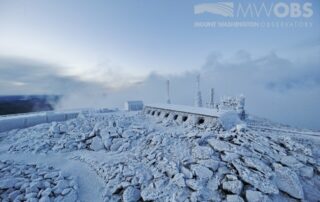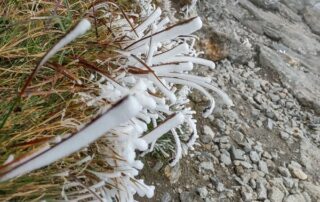Mount Washington Observatory Observer Blog
Brutal Cold on Mount Washington: A Weather Story
Brutal Cold on Mount Washington: A Weather Story Hello! My name is Karl Philippoff and I am a new weather observer at Mount Washington Observatory. Although I am from New Jersey, I have been up on the summit multiple times – once as a tourist, once as a thru-hiker, once as a summit volunteer, and most recently as an intern. I am very excited to experience all that a winter on Mount Washington has to offer. I also feel incredibly lucky to have one of the most beautiful views I can imagine from my desk, looking out at the
2022 By The Numbers
2022 By The Numbers January has arrived, a time of year to not only look forward to what might occur in the coming year but also a time to look back and reflect on the previous year. Looking back at weather stats, I would summarize 2022 weather conditions on the summit as warm, wet (however, not snowy), foggy, and windy. To find out why these words were chosen, let's look back at some of the stats from last year. Our average temperature for 2022 was 29.3°F (-1.5°C), which is 1.3°F above the 1991-2020 30-year normal for our station. The
Autumn 2022 Weather Was Warm, Wet, and Less Snowy
Autumn 2022 Weather Was Warm, Wet, and Less Snowy The fall of 2022 on Mount Washington will go down in the record books as a warm, wet, and less snowy season compared to average. September started the season off on a slightly cooler note, with an average temperature of 42.8 degrees. This temperature corresponded with an anomaly of 0.3 degrees below the 1991-2010 baseline. A tendency for ridging over the eastern United States during the month of October created the ideal conditions for anomalous warmth. In fact, at +6.4 degrees, October 2022 was the fifth warmest October in our
Christmas Bomb Cyclone Sweeps through the Northeast
Christmas Bomb Cyclone Sweeps through the Northeast Strong winds and heavy snow came to Mount Washington just in time for Christmas thanks to a nasty bomb cyclone sweeping through the Northeast. I wrote this comment Christmas morning at our summit weather station, where sustained winds exceeded 100 mph. What is a bomb cyclone and how does it form? A bomb cyclone forms when two very different air masses interact. Commonly, a cold, arctic mass shifts down from the north and a warm airmass is drawn into the storm. This type of system is defined by how rapidly it intensifies,
New Trail Signs Meant to Improve Weather Safety in the White Mountains
New Trail Signs Meant to Improve Weather Safety in the White Mountains New signs at trail heads leading to upper elevations in the White Mountains state the following, WARNING: Weather Conditions At High Elevations May Be Dangerous. For information from the Mount Washington Observatory about weather conditions & high elevation forecasts, text "weather forecast" to 603-356-2137. A project led by Observatory Life Trustee Jack Middleton to design and print over 100 warning signs for display at White Mountain trailheads was recently completed. The bright yellow signs, printed on 1/8” sturdy metal, warn of potentially dangerous weather at higher elevations
It’s Cooler at the Top
It's Cooler at the Top Capturing the moment while doing field research below Mount Washington. There’s a lot that goes on at the summit of Mount Washington. As many know, one of Mount Washington Observatory’s core priorities is to observe the weather. Observers take an observation every single hour of the day, adding to our 90-year (and counting!) climate record and sharing our data to improve weather models for meteorologists, pilots, climbers, researchers, weather enthusiasts, and other communities. As the fall intern, I’ve been able to participate in this work, and have also learned how to write the twice-daily
Forecast Discussion is Key to Interpreting Complex Mountain Weather
Forecast Discussion is Key to Interpreting Complex Mountain Weather As a meteorologist, I’ve had opportunities to forecast for a wide variety of environments and audiences. From the roads of Vermont to the valleys of California and climbers ascending Mount Everest, I’ve learned a lot about forecasting. At least that’s what I believed before starting to predict the weather at New England’s highest summit. In my few months here, I’ve been humbled on several occasions when forecasting this mountain’s dynamic weather. Mount Washington has taken me to task. What I am going for here is not the sympathy of the
Returning to Mount Washington Observatory
Returning to Mount Washington Observatory Weather Observer & Education Specialist enjoys winter conditions on Sept. 24. Hello! My name is Alex Branton and I am a new Weather Observer & Education Specialist at Mount Washington Observatory. Although I am far from my home in Pensacola, FL, this is not my first time on the summit. Last summer, I was an intern here, and I fell in love with the job and the White Mountains. I am so excited to return and experience all the extreme weather Mount Washington has to offer. During September, I have experienced many “firsts” on
Septem-burrr!
Septem-burrr! 2022-09-25 20:07:59.000 - Ryan Knapp, Weather Observer/Staff Meteorologist The summit of Mount Washington has experienced freezing temperatures and rime/glaze ice three times (so far) this month. And with the recent cold snap, the summit also received some snow/sleet. When we posted images and videos about the cold, snow, and ice, a common comment each time was something along the lines of, “It seems early.” For valley locations around here, you would likely be correct. However, for mountainous terrain in NH, winter weather in September is common. In fact, for the summit of Mount Washington, September is the month
Meteorological Awe-tumn
Meteorological Awe-tumn 2022-09-20 15:08:56.000 - Sam Robinson, Weather Observer/Engineer September marks the beginning of meteorological autumn, which is my favorite season, especially on the summit. Variety is the theme for this season with a little bit of everything to be expected! We are just over half way through the month and we have already experienced a couple days reaching 60 degrees and a couple falling below freezing, with plenty of in between. Up on the summit, I have been lucky enough to already get a little taste of winter on two separate occasions. Very fittingly on the first day
Search with Text

